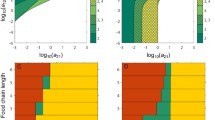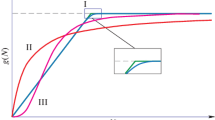Abstract
Hairston, Slobodkin, and Smith conjectured that top down forces act on food chains, which opposed the previously accepted theory that bottom up forces exclusively dictate the dynamics of populations. We model food chains using the Lotka–Volterra predation model and derive sustainability constants which determine which species will persist or go extinct. Further, we show that the productivity of a sustainable food chain with even trophic levels is predator regulated, or top down, while a sustainable food chain with odd trophic levels is resource limited, which is bottom up, which is consistent with current ecological theory.



Similar content being viewed by others
References
Chauvet E, Paullet J, Previte JP, Walls Z (2002) A Lotka–Volterra three species food chain. Math Mag 75(4):243–255
DeAngelis D (1992) Dynamics of nutrient cycling and food webs. Chapman and Hall, London
Fretwell SD (1977) The regulation of plant communities by the food chains exploiting them. Perpsect Biol Med 20:169–185
Gard T, Hallam T (1979) Persistence in food webs-I Lotka–Volterra food chains. Bull Math Biophys 41:877–891
Gopalsamy K (1984) Global asymptotic stability in Volterra’s population systems. J Math Biol 19:157–168
Hairston N, Smith F, Slobodkin L (1960) Community structure, population control, and competition. Am Nat 94(879):421–425
Harris S, Paullet JE, Previte JP, Ranola J (2005) A Lotka–Volterra four species food chain (unpublished)
Harrison GW (1979) Global stability of food chains. Am Nat 114(3):455–457
Heath M, Speirs D, Steele J (2013) Understanding patterns and processes in models of trophic cascades. Ecol Lett. doi:10.1111/ele.12200
Lotka AJ (1925) Elements of physical biology. Williams and Wilkins Co, Baltimore
Odum E (1953) Fundamentals of Ecology. W. B. Saunders Company, Philadelphia
Oksanen L, Fretwell S, Arruda J, Niemela P (1981) Exploitation ecosystems in gradients of primary productivity. Am Nat 118:240–261
Persson L, Diehl S, Johansson L, Andersson G, Hamrin SF (1992) Trophic interactions in temperate lake ecosystems: a test of food chain theory. Am Nat 140(1):59–84
Polis GA, Strong DR (1996) Food web complexity and community dynamics. Am Nat 147(5):813–846
Roy A, Solimano F (1987) Global stability and oscillations in classical Lotka–Volterra loops. J Math Biol 24:603–617
Smith DW (2005) Ten years of yellowstone wolves, 1995–2005. Yellowstone Sci 13(1):7–31
Volterra V (1931) Variations and fluctuations of the number of individuals in animal species living together. In: Chapman R (ed) Animal Ecology. McGraw-Hill, New York
Wollrab S, Diehl S, Roos AD (2012) Simple rules describe bottom-up and top-down control in food webs with alternate energy pathyways. Ecol Lett 15(9):935–946
Acknowledgments
We thank the reviewers for their insightful comments and helpful suggestions. J.P.P. acknowledges support from NSF-DMS-9987594, NSF-DMS-0236637, and NSF-DMS-0552148 for foundational work that led to the formulation of this problem.
Author information
Authors and Affiliations
Corresponding author
Rights and permissions
About this article
Cite this article
Massarelli, N., Hoffman, K. & Previte, J.P. Effect of parity on productivity and sustainability of Lotka–Volterra food chains. J. Math. Biol. 69, 1609–1626 (2014). https://doi.org/10.1007/s00285-013-0746-7
Received:
Revised:
Published:
Issue Date:
DOI: https://doi.org/10.1007/s00285-013-0746-7
Keywords
- Sustainability
- Lotka–Volterra predator–prey equations
- Hairston, Slobodkin, and Smith conjecture
- Parity of food chains




